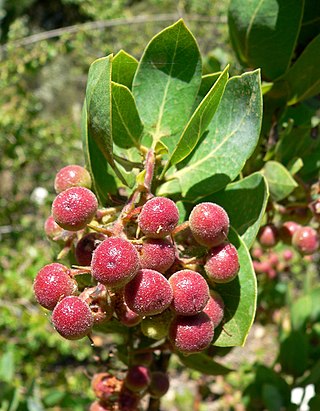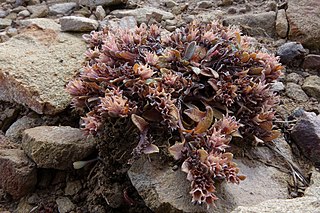
A spruce is a tree of the genus Picea, a genus of about 35 species of coniferous evergreen trees in the family Pinaceae, found in the northern temperate and boreal (taiga) regions of the Earth. Picea is the sole genus in the subfamily Piceoideae. Spruces are large trees, from about 20 to 60 m tall when mature, and have whorled branches and conical form. They can be distinguished from other members of the pine family by their needles (leaves), which are four-sided and attached singly to small persistent peg-like structures on the branches, and by their cones, which hang downwards after they are pollinated. The needles are shed when 4–10 years old, leaving the branches rough with the retained pegs. In other similar genera, the branches are fairly smooth.

The blue shark, also known as the great blue shark, is a species of requiem shark, in the family Carcharhinidae, which inhabits deep waters in the world's temperate and tropical oceans. Averaging around 3.1 m (10 ft) and preferring cooler waters, the blue shark migrates long distances, such as from New England to South America. It is listed as Near Threatened by the IUCN.

Nicotiana glauca is a species of flowering plant in the tobacco genus Nicotiana of the nightshade family Solanaceae. It is known by the common name tree tobacco. Its leaves are attached to the stalk by petioles, and its leaves and stems are neither pubescent nor sticky like Nicotiana tabacum. It resembles Cestrum parqui but differs in the form of leaves and fusion of the outer floral parts. It grows to heights of more than two meters.

Cedrus atlantica, the Atlas cedar, is a species of tree in the pine family Pinaceae, native to the Rif and Atlas Mountains of Morocco, and to the Tell Atlas in Algeria. A majority of the modern sources treat it as a distinct species Cedrus atlantica, but some sources consider it a subspecies of Lebanon cedar.

Citrus glauca, commonly known as the desert lime, is a thorny shrub or small tree native to Queensland, New South Wales, and South Australia. The 1889 book The Useful Native Plants of Australia records common names native kumquat and desert lemon.

Canna glauca is a species of the Canna genus, a member of the family Cannaceae. It is commonly known as water canna or Louisiana canna. It is native to the wetlands of tropical America and was introduced to England in 1730. It is also reportedly naturalized in Sri Lanka, Thailand, Vietnam, Java and the Philippines.
Abarema glauca, the glaucous abarema, is a tree species in the legume family (Fabaceae). It is found in the Bahamas, Cuba, and Hispaniola. Abarema glauca is found most easily on the east coast of Dominican Republic, in Uvero Alto, north of Punta Cana.
Microkayla adenopleura is a species of frog in the family Strabomantidae. It is endemic to Bolivia and only known from near its type locality in the Carrasco National Park, Cochabamba Department, at elevations of 3,250–3,400 m (10,660–11,150 ft) asl. It is a common species living in low, humid montane forest typical to the transition between Yungas forest and páramo. Outside the national park, if present, it would be threatened by habitat loss.
Psychrophrynella bagrecito is a species of frog in the family Strabomantidae. It is endemic to the Cusco Region, Peru, and found on the Amazonian slopes of the Andes at elevations of 1,830–2,740 m (6,000–8,990 ft) asl. The specific name bagrecito is Spanish meaning a small catfish, and a nickname for David C. Cannatella, a colleague of John D. Lynch, the scientist who described the species from specimens collected from near Marcapata.
Microkayla kempffi is a species of frog in the family Strabomantidae. It is endemic to Bolivia where it is known from the Serranía Siberia in the Cochabamba and Santa Cruz Departments. Its natural habitats are cloud and elfin forests where it has been found near rocks along a road, under stones and logs, on moss, and on tree roots. It can be active both day and night. It is threatened by habitat loss, and potentially, by climate change.
Microkayla pinguis is a species of frog in the family Strabomantidae. It is endemic to Bolivia and only known from its type locality in Inquisivi Province, La Paz Department. It is known from an area consisting of a mixture of elfin forest and pastures, where it was found under stones in a humid stream bed. Smallholder agriculture and climate change are potential threats to this species.

Arctostaphylos glauca is a species of manzanita known by the common name bigberry manzanita. It is native to California and Baja California, where it grows in the chaparral and woodland of coastal and inland hills.

Spruce-pine-fir (SPF) is a classification of lumber that can be traded on commodities exchanges.

Smilax glauca, the cat greenbriar or catbriar is a woody vine in the family Smilacaceae. It is native to central and eastern portions of the United States as well as Mexico, where it is a common and conspicuous part of the forest vegetation.

Psychrophrynella is a genus of frogs in the family Strabomantidae The genus is distributed on the Andes of southern Peru and Bolivia. One of the four species assessed by the International Union for Conservation of Nature (IUCN) is assessed as "Critically Endangered".

Psychrophrynella usurpator is a species of frogs in the family Strabomantidae. It is endemic to Peru and known from near Abra Acjanacu, a mountain pass in the Cordillera de Paucartambo, the easternmost Andean range towards the Amazonian lowlands, and from the high elevation grasslands of the Manu National Park. It is named usurpator because these frogs were previously misidentified as Noblella peruviana—in a sense, they had "usurped" the name of another frog species.

Psychrophrynella chirihampatu is a species of frogs in the family Strabomantidae. It is endemic to Peru and known only from its type locality, the Japumato Valley in the Peruvian Andes of the Cusco. The common name Japumayo Andes frog has been coined for this species.
Qosqophryne is a genus of strabomantid frogs. These frogs are endemic to south-eastern Peru in the Cusco Region at 3270 to 3800 meters above sea level. A phylogenetic analysis found Qosqophryne as sister to the genus Microkayla and that this clade was more closely related to Noblella and Psychrophrynella than to other species in Bryophryne.
Angelica glauca, the smooth angelica, is a species of flowering plant in the family Apiaceae. It is found from eastern Afghanistan through the western Himalayas to western Tibet. Collecting in the wild for its essential oil has driven this species to Endangered status.

Myosotis glauca is a species of flowering plant in the family Boraginaceae, endemic to the South Island of New Zealand. George Simpson and J.S. Thomson described M. pygmaea var. glauca in 1942, and Peter de Lange and John Barkla recognized it at species rank in 2010. Plants of this species of forget-me-not are perennial with a prostrate habit, bracteate inflorescences, white corollas, and often glaucous grey leaves.











